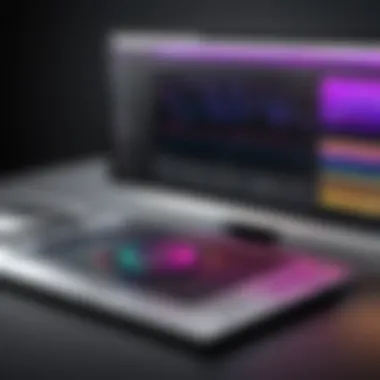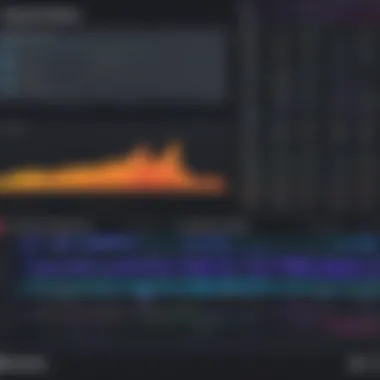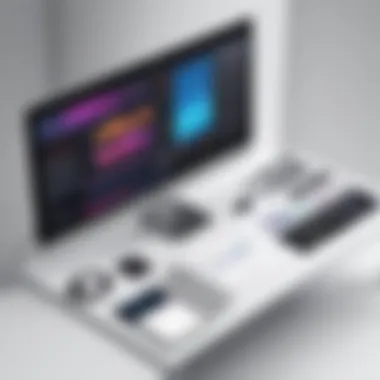Soundtrap: A Comprehensive Review for Musicians


Intro
In the landscape of music production, Soundtrap stands out as an intriguing option. This cloud-based music creation platform appeals to a diverse audience, ranging from hobbyist musicians to established producers. It enables users to collaborate in real-time, which is increasingly important in today’s interconnected world. This analysis aims to provide an in-depth look at Soundtrap, evaluating its functionalities, strengths, and weaknesses.
Understanding the capabilities of tools like Soundtrap is crucial for anyone in the music industry. The seamless integration of technology into music production processes presents both opportunities and challenges. Hence, carefully examining platforms like Soundtrap helps users make proficient choices based on their needs.
Software Overview
Soundtrap’s structure and features are essential for grasping its potential application in music production. With an emphasis on accessibility, it allows users to create music without needing extensive technical knowledge. Soundtrap's design focuses on providing an attractive interface and user-friendly experience.
Software Features
Soundtrap offers an array of features that cater to various aspects of music production. The notable features include:
- Real-time Collaboration: Users can work together on projects simultaneously, a major advantage for teams spread across different locations.
- Built-in Instruments and Loops: There is a wide selection of virtual instruments and audio loops available, which are pivotal for enhancing creativity.
- Audio Recording: Users can record vocals or instruments directly into the platform.
- Automation and Effects: Soundtrap includes various automation options and audio effects, which are essential for mixing tracks effectively.
- Cross-Platform Compatibility: The platform operates in any web browser, providing access from different devices without the need for installation.
Technical Specifications
Soundtrap operates entirely online, utilizing cloud technology. It requires an internet connection, which can be a limitation for some users. The system specifications to consider include:
- Browser Requirements: Most modern internet browsers like Google Chrome, Firefox, and Safari are supported.
- System Requirements: Soundtrap is designed to function on Windows, macOS, and even on mobile devices, although the experience may vary across platforms.
- Account Types: Users can choose between a free version with basic features and subscription plans that offer advanced functionalities.
Peer Insights
Gaining insights from actual users provides a clearer picture of what to expect from Soundtrap. These experiences reveal both the strengths and the limitations of the platform, making it essential to consider varied perspectives.
User Experiences
Users praise Soundtrap for its intuitive interface, which enables both new and experienced music producers to navigate the platform easily. Collaborators often highlight the ease with which they can invite others to projects. However, some users have expressed concerns over the limitations of the free version, which may hinder those wanting extensive capabilities.
Pros and Cons
Pros:
- Easy to use, even for beginners.
- Effective for collaboration, allowing multiple users in real-time.
- Accessible on multiple devices, enhancing flexibility.
Cons:
- Internet dependency could limit access.
- The free version has significant limitations.
- Some advanced features may not match dedicated software tools.
"Soundtrap has changed how I approach music making, especially when working with others. The real-time features offer something unique, but I wish the free version had more to offer." - User Review
In summary, this analysis illustrates the capabilities and limitations associated with Soundtrap. \nUnderstanding user experiences alongside feature evaluation paints a comprehensive picture that assists potential users in making informed decisions about their music production needs.
Foreword to Soundtrap
In contemporary music production, the tools and platforms available are numerous, each catering to specific needs of musicians and producers. Soundtrap is one such platform that has gained notable attention in recent years. This section delves into its significance within the music production landscape, highlighting how it addresses the demands of modern creators.
Soundtrap is a cloud-based music studio that allows users to create and collaborate on music remotely. Its appeal lies in its accessibility and flexibility, making it suitable for various skill levels, from beginners to seasoned professionals. By eliminating barriers of entry often found in traditional software, Soundtrap has positioned itself as a viable option for many.
The importance of Soundtrap also stems from its collaborative features. In an era where teamwork often defines the success of creative projects, Soundtrap enables multiple users to work together in real time, even if they are miles apart. This is particularly beneficial for those in the music industry today, where collaboration has become a fundamental aspect of the creative process.
Another key element of this platform is its integration capabilities. As technology advances, the need for seamless interaction between different tools and software becomes crucial. Soundtrap connects with various music production software and tools, enhancing its functionality and allowing users to incorporate their preferred resources effortlessly.
What is Soundtrap?


Soundtrap is an easy-to-use, web-based digital audio workstation (DAW) designed to facilitate music production. It caters to musicians seeking a straightforward interface that does not compromise on quality or functionality. Users can record, edit, and mix their sounds within one unified platform.
Key functions of Soundtrap include:
- Multi-track editing: This allows users to layer sounds effectively, promoting intricate compositions.
- Loop Library: An extensive library of audio loops and samples provides a foundation for various music genres.
- Effects and Plugins: The platform supports different audio effects that enhance the sound quality of recordings.
- Export Options: Users can easily export their projects to share with others or distribute them through various channels.
Overview of Its Development
Soundtrap was founded in 2012 by a group of music enthusiasts who envisioned an accessible music creation tool for everyone. The platform was designed to address the growing need for online collaboration in music production, seen especially in environments where traditional software posed challenges.
Over the years, Soundtrap has evolved, incorporating user feedback to enhance its functionality. Updates have introduced new features that keep the platform competitive with other DAWs. As of late, Soundtrap has broadened its reach by integrating educational tools for schools, making music creation part of the learning experience.
This progressive approach ensures that Soundtrap remains a relevant option in the fast-evolving digital music landscape. Its commitment to user experiences has helped it carve out a niche as a preferred tool for both hobbyists and serious musicians in the music industry.
Key Features of Soundtrap
Understanding the key features of Soundtrap is essential to evaluate its effectiveness for music production. This section examines the specific functionalities that make Soundtrap a notable choice for various users. Highlighting these features will shed light on their relevance, benefits, and considerations that inform potential users' decisions.
User Interface and Usability
Soundtrap prides itself on a user-friendly interface that caters to both novices and experienced musicians. The layout is designed with ease of navigation in mind. Users can intuitively find tools to record, edit, and mix music without extensive prior knowledge. For beginners, this simplicity can lower the initial barrier to entry, facilitating a smoother learning curve.
The platform uses a drag-and-drop mechanism which streamlines the process of arranging MIDI tracks and audio clips. Furthermore, the color-coded sections and clearly labeled icons help users identify functions quickly. This focus on usability allows musicians to concentrate more on creativity rather than getting bogged down in technical complexities.
Collaboration Tools
One of the standout features of Soundtrap is its robust collaboration tools. Musicians can work together in real-time, regardless of their physical location. This functionality is particularly valuable in an increasingly remote world. Users can invite others to their projects, enabling multiple participants to contribute simultaneously.
Soundtrap supports audio and text chat, allowing collaborators to communicate effortlessly during the production process. This seamless interaction fosters creativity and enhances the overall workflow. Whether it's brainstorming ideas or providing feedback, the collaboration options significantly broaden the scope for creative partnerships.
Integration with Other Platforms
Soundtrap has made notable strides in integrating with various platforms and services. By connecting with tools like SoundCloud and Spotify, users can share their creations more effectively. This ease of integration allows for a fluid transition from creation to sharing, an essential factor for today’s music producers.
Moreover, Soundtrap offers MIDI file import and export capabilities. This feature ensures compatibility with other digital audio workstations (DAWs). It allows for flexibility, enabling users to shift their work between Soundtrap and other software, creating a networked ecosystem for music production.
Built-in Instruments and Loops
The array of built-in instruments and loops in Soundtrap significantly enhances its appeal. Users can access a diverse library of sounds, ranging from synthesizers to acoustic instruments. This variety allows users to experiment with different genres and styles, enriching their creative process.
Additionally, Soundtrap frequently updates its library, providing fresh content for users. The presence of quality loops and samples can spur musical inspiration and guide users through the production process. It is an essential consideration for those focused on producing polished, engaging tracks.
Accessibility Across Devices
Soundtrap’s cloud-based architecture means that it is accessible across various devices. Whether using a desktop computer, tablet, or smartphone, musicians can engage with their projects anytime and anywhere. This flexibility is crucial for today’s fast-paced lifestyle, where opportunities for inspiration can arise unexpectedly.
The responsive design of the platform ensures that users have a consistent experience, regardless of their device. This means that whether you are in the studio or on the go, your projects are always at your fingertips, ready for tweaking or fresh ideas.
"Soundtrap exemplifies modern music production by bringing collaboration and accessibility to the forefront of creativity."
Analyzing Soundtrap for Different Users
The examination of how Soundtrap caters to different types of users is crucial. Each group has unique needs and varying levels of experience that can significantly influence their music production workflows. Understanding these differences allows potential users to gauge Soundtrap’s suitability based on their individual skill levels and requirements in music creation. Here, we will explore how the platform serves beginners, intermediate musicians, and professionals, focusing on the specific functionalities that cater to each group.
For Beginners


Beginners often seek user-friendly tools that allow them to learn and experiment with music production without being overwhelmed. Soundtrap excels in making the entry into music creation accessible.
- Intuitive Interface: The simple layout of Soundtrap makes it easy for newcomers to navigate its features. Menus are clearly labeled, and most functions can be grasped quickly.
- Tutorials: Soundtrap provides a range of tutorials and resources, guiding users on how to utilize various functions effectively. This support is key to building confidence in new users.
- Collaboration: The ability to collaborate with others introduces beginners to a community atmosphere, facilitating learning through interaction with more experienced users.
Beginners can benefit greatly from these aspects, allowing them to focus on creativity rather than technical barriers.
For Intermediate Musicians
Intermediate musicians often have a grasp of the basic concepts of music production and seek more advanced features to expand their capabilities. Soundtrap responds to this need through:
- Expanded Instrument Options: Intermediate users will appreciate the range of built-in instruments and loops that can be manipulated to create unique sounds.
- Enhanced Effects: The platform provides various audio effects, allowing users to enhance their tracks more creatively. This addition permits intricate sound design without needing third-party plugins.
- Project Collaboration: Advanced collaborative tools facilitate working with multiple artists, which enriches the creative process.
These features empower intermediate users to refine their skills and explore deeper production techniques.
For Professionals
For seasoned professionals, high-level functionality is paramount. Soundtrap caters to this demographic through:
- Cloud-Based Flexibility: Professionals often need the ability to work from any location. Soundtrap’s cloud nature allows users to access their projects seamlessly across different devices.
- Integration Capabilities: The platform’s integration with other DAWs and tools can enhance a professional's workflow. This means they can bring in their favorite plugins or transfer projects as needed.
- High-Quality Output: Professionals demand excellent sound quality. Soundtrap is designed to meet industry standards, ensuring that users can create competitive music.
Comparative Analysis
In evaluating Soundtrap, a comparative analysis is essential for understanding its standing in the broader music production landscape. By placing Soundtrap alongside other prominent platforms, users can assess its unique features, value, and potential areas of improvement. Through comparison, one can identify strengths and weaknesses, providing clarity on how these platforms cater to different users—from beginners to seasoned professionals.
Soundtrap vs. Competitors
When dissecting how Soundtrap fares against its competitors, several key platforms emerge as notable comparisons. Each offers distinct characteristics that appeal to various segments of the music production community.
GarageBand
GarageBand is widely recognized, particularly among Mac users, for its intuitive design and user-friendly interface. This software excels in offering an extensive library of sounds and loops, making it especially beneficial for beginners. A key characteristic of GarageBand is its seamless integration with macOS and iOS devices, allowing users to record on-the-go.
One unique feature of GarageBand is the Live Looping function. This feature allows users to experiment with musical ideas in real-time, making the creative process more dynamic. However, GarageBand's reliance on Apple devices can be a drawback for users on other platforms. This makes it less accessible for those who prefer Windows or Android-based systems.
BandLab
BandLab brings a modern twist to music production, emphasizing social interaction alongside its creation features. By providing a cloud-based platform, it allows users to collaborate in real-time and share their projects effortlessly. A standout characteristic of BandLab is its extensive social features, such as the ability to follow other users and share music creations within a community.
BandLab’s unique offering is its multi-track editor, which provides an array of tools for layering and production. This can be a significant advantage for users looking to create complex compositions without the cost associated with traditional DAWs. However, some may find the abundance of social features overwhelming if they are primarily focused on production rather than collaboration.
FL Studio
FL Studio is revered among professional music producers for its robust feature set and versatility. It stands out due to its powerful automation and MIDI capabilities, appealing to serious creators looking for depth and control. A vital characteristic of FL Studio is its piano roll, which is often regarded as the best in the industry, allowing for detailed note editing and arrangement.
The unique feature of FL Studio is its lifetime free updates, which ensures that users get the latest enhancements without additional costs. This model makes it a financially sound option in the long run. However, its steep learning curve could deter beginners, as the interface may appear daunting without prior experience.
Cost-Effectiveness
Cost-effectiveness remains a crucial consideration for users evaluating music production software. Soundtrap offers a variety of pricing tiers that are competitive, especially for those at the entry-level. By examining the costs associated with the different platforms, users can make informed decisions based on their budget and production needs."
User Feedback and Experiences
Understanding user feedback and experiences is crucial in evaluating Soundtrap's effectiveness as a music production platform. This feedback provides insight into real-world usage, beyond theoretical features and capabilities. Vocalization of experiences highlights aspects like usability, feature performance, customer support, and overall satisfaction. Users' opinions inform potential users about both strengths and weaknesses of the product.
By engaging with user feedback, we can better understand how Soundtrap fits in the larger context of music production. This section examines feedback through positive remarks and common critiques.


Positive Aspects
Many users praise Soundtrap for its simplicity and ease of use. Beginners often find the interface intuitive, allowing them to focus on creativity instead of technicalities. The cloud-based design is also a notable advantage. This means users can access their projects from any device, which increases flexibility and convenience.
Another frequently mentioned benefit is the collaboration feature. Musicians can connect with others in real-time, enabling dynamic teamwork for projects. Features like video chat within the platform enhance this collaborative experience further. The wide range of built-in instruments and loops is also welcomed by users, providing a diverse palette for creation without needing external resources.
Users have also highlighted the responsive customer support. When issues do arise, users report positive experiences with the response times and resolutions.
Common Critiques
Despite the positive feedback, several common critiques have emerged from users. A notable concern is related to pricing, especially for the premium features. Some musicians feel that certain capabilities behind the paywall could be essential but are not accessible without additional costs.
Performance issues during high-demand sessions also appear in user feedback. Some users report problems with latency when using multiple tracks, which can hinder the creative process. Additionally, file export options have been criticized, with users wishing for more formats and quality settings to choose from.
Overall, the feedback showcases Soundtrap's strengths in usability and collaboration but also indicates areas where improvement is necessary. This balance helps inform potential new users and highlights the software's evolving nature as it grows within the industry.
Future of Soundtrap
The future of Soundtrap plays a vital role in understanding its position in the music production market. As a cloud-based platform, Soundtrap needs to adapt continuously to technological advancements and user demands. Its development path determines how effectively it can compete with other software and sustain a loyal user base.
Looking ahead, the evolution of digital music production software depends on integrating more advanced features. These enhancements not only improve usability but also expand the possibilities for creativity. As remote collaboration becomes commonplace, Soundtrap's capabilities in this area will likely see significant growth.
Upcoming Features
Based on current trends and user feedback, several promising features may be on the horizon for Soundtrap. Users may expect enhanced audio editing tools which can simplify the process of manipulation and arrangement. Furthermore, the introduction of better MIDI support could help musicians achieve more intricate compositions with greater ease.
The possibility of integrating machine learning tools is also noteworthy. Such technology can assist in sound generation, mixing, and even suggest harmonies, thereby streamlining the creative process. Additionally, improvements in the mobile app may enhance accessibility for users on-the-go, catering to a broader audience.
Other anticipated updates may include:
- Expanded library of loops and samples: This addition can assist users in diversifying their sound palettes.
- Collaborative features: Further advancements could make real-time collaboration more fluid and engaging.
Market Trends in Music Production Software
To understand the future of Soundtrap, it is essential to consider the overall market trends in music production software. The shift towards cloud-based solutions is a significant factor. Musicians and producers increasingly seek platforms that allow for seamless collaboration and easy access to projects from various devices.
The rise of influencer culture and podcasting also influences software development. Many artists now prioritize user-friendly interfaces and accessibility that attract novice musicians. As such, platforms like Soundtrap must address these trends to remain relevant.
Moreover, there is an increasing demand for integration with social media and streaming services. This integration enhances marketing capabilities and makes it easier for users to share their work. Soundtrap's ability to evolve alongside these trends is vital for its sustained success in the competitive landscape of music production.
Final Assessment
In this section, we will critically evaluate Soundtrap, establishing whether it lives up to the expectations set through earlier sections. A thorough final assessment is crucial as it synthesizes the insights gathered throughout the article regarding Soundtrap’s capabilities, usability, and market position. The aim is to offer readers a balanced overview while helping them make an informed decision when selecting a music production platform.
Is Soundtrap Worth It?
Determining the worth of Soundtrap relies on examining various aspects such as features, cost, and user experience. The platform is designed for ease of use, making it accessible for both beginners and experienced musicians. Users appreciate the interface and collaboration tools that facilitate real-time music creation.
One significant benefit is the pricing model. Soundtrap offers a free version with basic functionalities, allowing users to test the platform before committing financially. The premium versions offer expanded features, including higher audio quality and additional loops, which enhance the creative process.
However, it is also important to consider some limitations. Users often mention that the feature set, while robust, does not completely rival more established Digital Audio Workstations (DAWs) like Ableton Live or FL Studio.
To sum it up, Soundtrap is worth exploring, particularly for users who prioritize collaboration and cloud access. It accommodates a range of musical styles and production needs, making it a valuable tool in many cases.
Ideal Users of Soundtrap
Identifying the ideal users of Soundtrap involves understanding its unique strengths. The platform is well-suited for:
- Beginners: Those new to music production benefit from the intuitive design and resources available for learning.
- Collaborative musicians: Soundtrap's real-time collaboration tools attract bands and groups who create music together remotely.
- Teachers and students: The platform's collaborative approach is an excellent fit for educational settings, allowing students to learn and create music together.
While less ideal for professional studio environments requiring extensive capabilities, Soundtrap provides sufficient tools for independent creators, hobbyists, and educators.







